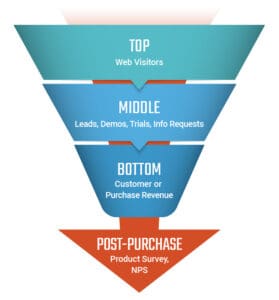Data, data everywhere, not an insight in sight. You probably have encountered this contradiction if you’re a business leader trying to use data to manage your business. It’s not that you don’t have access to data. Likely, it’s that you have more than you can handle.
Over time you’ve collected various tools and platforms that produce a great deal of data each month. Yet, when you try to answer the simple question “did we do better this month versus last month” it’s not always easy to produce a clear answer.
Typically the problem is not a lack of data. It’s a lack of the ability to consistently report and understand the data. In this article, we’ll explore the underlying roots of that problem and suggest some solutions.
How Industries Affect Key Performance Indicators
Key Performance Indicators (KPIs) are typically tied to the type of customers your organization is selling to (user) and to the person who is paying for the product (buyer). Sometimes the user and buyer are the same, but not always. Additionally, KPIs will vary based on industry.
For example, a manufacturer is typically selling to other businesses such as retailers or wholesalers. Even if an individual consumer is the final buyer (and user), the manufacturer is paid by an intermediary distributor. Online or physical storefront retailers are selling directly to individual consumers.
On the other hand, media companies typically sell to both subscribers directly and to businesses in the form of advertising. The same goes for banks that sell both to retail depositors and companies seeking loans. As in the last two cases, there are often some combination of both direct individual sales channels and channels for bulk sales to institutional buyers.
Mapping KPIs to the Customer Journey
No matter what type of business you’re running, one great way to choose a set of KPIs is to follow the customer journey.
To do this, choose one metric that represents each phase of the sales process, from the earliest interests to the product satisfaction scores. The basic framework goes from the top of the funnel to post-purchase.
To help illustrate this approach, here are five metrics worth tracking.
1. Sales Trends
The most important metrics overall are typically related to sales in the form of cash in the door each month. There is a reason public companies stock prices react to earnings reports. Sales trends are the bedrock indicator of business performance. Whether you are selling to businesses or individual buyers, sales represent customers voting with their wallets.
The rate of sales growth or decline can tell you if the wind is at your back or you need to take corrective action with tactical campaigns.
In addition, you’ll want to keep a close eye on trends within the topline revenue such as product mix trends, new versus existing customer purchases and any other segment trends that indicate shifts in the market, either on a short-term basis or buying patterns you’ve been watching that might lead you to initiate wholesale strategic changes.
2. Website Traffic
Almost all businesses have a website. Typically the tool measuring visits to the website is either Google Analytics or Adobe Analytics, although there are others. Using these tools you can measure visitors each month and compare that to the same month for the prior year. Visitors represent a broad indication of interest in your company or brand.
Every executive who touches customer revenue should see that number. There are various reasons the number can go up or down, but the topline visitor number gives everyone a benchmark to assess and is a great metric to kick off deeper analysis and performance conversations.
Next, a key aspect of measuring performance for most businesses is a conversion metric.
3. Conversions
Conversions represent an action that indicates interest in a purchase such as signing up for a free trial, demo or request for more information. Typically this metric is one of the best indicators of future sales so ensuring it’s growing is a great way to ensure sales growth.
It also is a very important metric for your marketing teams to qualify traffic and ensure the visitors they are driving to the website are actually converting. That way you can guarantee that advertising spending is leading to business outcomes, such as leads and purchases.
4. Customer Satisfaction
Customer satisfaction is a key indicator of product health. Product teams need to align their roadmaps with customer insights to ensure the product is meeting customer needs, also known as “product-market fit.” Gathering this data can take many forms. No matter what exact survey method, it’s critical to capture feedback on your product from customers in both quantitative and qualitative ways.
A great example of this is the net promoter score (NPS) which asks customers “how likely are you to to recommend this product to a friend or colleague” on a scale of one to ten (numerical) and then “why did you give this score” with an open-text response (qualitative).
I usually take the qualitative comments and bucket them into groups to help tease out a few common themes that are driving high and low scores.
5. Business Performance
For ecommerce companies, the mix of products being purchased or basket analysis is a key indicator of what products are driving sales and allow marketers to run campaigns aligned with those trends. For other companies the most important metric might be monitoring canceled or returned orders to understand early indicators of weakness in products or larger market dynamics.
Another example might be a version of an “industry buzz metric” like mentions by influencers or product ratings websites. Whatever you pick to round out your top KPIs, it should represent a key indicator of business health.
So, to recap here’s a list of KPIs you should be reviewing with your teams within the first week of each new month:
- Sales revenue
- Website visitors
- Trial/demo or other conversion metric
- Customer satisfaction
- Carts, cancels and influencers
Data Management Best Practices
Consistency is Key to KPI Success
The truth is that there will always be an endless list of additional metrics needed once you start asking questions and digging into the numbers. However, a few simple, consistent KPIs are important because they represent broad yet diverse areas of business performance.
Data Should be Democratized
One common pitfall is that reporting is siloed, with a few key executives relying on a custom report their group built at one time or another. Suppose you allow each team to cherry-pick a metric that’s too narrow, obscure, variable or untrusted.
In that case, you’ll spend time endlessly debating the number’s validity instead of unlocking collective insights. This can really harm effective business planning. Along with thinking through which KPIs matter, you’ll need to work with cross-functional teams to set up a better reporting process.
Historically, many reports were emailed Excel files. Today it’s common to provide access to performance dashboards. Whatever the case in your organization, it’s important to ensure the users of the reports have a method of requesting refinements and asking questions about exactly how data is being calculated.
However, it’s also essential for reporting to be owned and to have an authoring team that can defend reporting decisions while also accepting feedback without rolling over to every request.
Utilize a Data Team or Appoint a Data Leader
To get consistent data, you’ll need a department, team or person responsible for producing and distributing the reports. This is always a contentious item as pulling data is likely to involve multiple players, from IT to marketing, with none necessarily feeling that it’s their core function.
In larger organizations, there might be an analytics or data team that can own the compilation and distribution of reports as well as manage the tools used to compile and distribute them.
Focus on Improving Data Maturity
Running a business and making decisions based on the data is an often repeated corporate mantra. But it’s not as easy as it sounds. Think about these questions for a moment:
- Who’s data do you use?
- How will it be compiled?
- How will it be cleaned?
- How will it be stored?
- How will it be distributed?
Take for example the question of monthly sales.
Will you use a cash in number from your ecommerce systems or one tracked by finance which might defer earnings based on accounting rules. Who’s job is it to categorize the product catalog into groups of products and do all the systems use the same taxonomy or groupings?
While there are many questions, helping your organization move up the data maturity curve by establishing clear KPIs at the company or business unit level is essential to long-term success.
Translate Data Insights into Business Strategy
Data Science for Business Leaders will show you how to partner with data professionals to uncover business value and make informed decisions. The world of data is moving fast; don’t get left behind. If you’re ready to gain powerful business insights with data, register today.
Author
-

Peter Milburn, a Digital Marketing Leader with 30 years of experience, boasts a distinguished record in online consumer and B2B marketing. His journey includes roles at Time Inc., Wiley, and Global Association of Risk Professionals. For questions or inquiries, please contact [email protected].
View all posts









